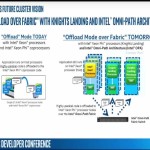Those who gave up for dead Intel’s Omni-Path fabric, which Intel began working on 2012 and stopped supporting seven years later, may want to re-think that. Cornelis Networks, the company breathing life into Omni-Path since 2020, has won an $18 million R&D contract from the U.S. National Nuclear Security Administration (NNSA). The award is part of DOE’s Next-Generation High Performance Computing Network (NG-HPCN) project….
Post-Exascale Fabric: NNSA Awards Cornelis Networks $18M for High Performance Network R&D
Omni-Path HPC Interconnect Reemerges as Intel Spin-out with $20M Investment Round from Intel Capital, Others
Left for dead last year, Intel’s Omni-Path Architecture (OPA) high performance fabric may come back to life with a Series A $20 million venture round involving Intel Capital, Downing Ventures and Chestnut Street Ventures that places OPA interconnect technology under the auspices of a spin-out start-up called Cornelis Networks. OPA was a much-promoted Intel effort […]
High Performance Interconnects: Assessment & Rankings
In this video from the HPC Advisory Council Spain Conference, Dan Olds from OrionX discusses the High Performance Interconnect (HPI) market landscape, plus provides ratings and rankings of HPI choices today. “In this talk, we’ll take a look at the technologies and performance of high-end networking technology and the coming battle between onloading vs. offloading interconnect architectures.”
Raj Hazra Presents: Driving to Exascale
Raj Hazra presented this talk at ISC 2016. “As part of the company’s launch of the Intel Xeon Phi processor, Hazra describes how how cognitive computing and HPC are going to work together. “Intel will introduce and showcase a range of new technologies helping to fuel the path to deeper insight and HPC’s next frontier. Among this year’s new products is the Intel Xeon Phi processor. Intel’s first bootable host processor is specifically designed for highly parallel workloads. It is also the first to integrate both memory and fabric technologies. A bootable x86 CPU, the Intel Xeon Phi processor offers greater scalability and is capable of handling a wider variety of workloads and configurations than accelerator products.”
Building Bridges to the Future
“The Pittsburgh Supercomputing Center recently added Bridges to its lineup of world-class supercomputers. Bridges is designed for uniquely flexible, interoperating capabilities to empower research communities that previously have not used HPC and enable new data-driven insights. It also provides exceptional performance to traditional HPC users. It converges the best of High Performance Computing (HPC), High Performance Data Analytics (HPDA), machine learning, visualization, Web services, and community gateways in a single architecture.”
Intel® Omni-Path Architecture—A Next-Generation HPC Fabric
Even though it’s a new generation fabric, Intel OPA is still backwards compatible with the many applications in the HPC community that were written using the OpenFabrics Alliance* software stack for InfiniBand. So, existing InfiniBand users will be able to run their codes that are based on the OpenFabrics Enterprise Distribution (OFED) software on Intel OPA. Additionally, Intel has open sourced the key software elements of their fabric to allow integration of Intel OPA into the OFED stack, which several Linux* distributions include in their packages.
InfiniBand Enables Intelligent Networks
“The path to Exascale computing is clearly paved with Co-Design architecture. By using a Co-Design approach, the network infrastructure becomes more intelligent, which reduces the overhead on the CPU and streamlines the process of passing data throughout the network. A smart network is the only way that HPC data centers can deal with the massive demands to scale, to deliver constant performance improvements, and to handle exponential data growth.”
Video: TACC Powers Stampede Supercomputer with Dell Servers and Intel Omni Path
In this video, Tommy Minyard from TACC describes how Dell helped develop the 9.6 Petaflop Stampede supercomputer for scientific computing. “The Texas Advanced Computing Center supports the University of Texas System and National Science Foundation researchers with the newest version of their Stampede High Performance Computing cluster. Stampede uses Dell PowerEdge servers, Intel Xeon processors and the new Dell Networking H-Series switches and adapters based on Intel Omni-Path Architecture. These newly implemented technologies greatly reduce latency, optimize traffic flow, and give Stampede a peak performance of 10 petaflops.”
Video: Diving into Intel’s HPC Scalable System Framework Plans
“In July, Intel announced plans for the HPC Scalable System Framework – a design foundation enabling wide range of highly workload-optimized solutions. This talk will delve into aspects of the framework and highlight the relationship and benefits to application development and execution.”
Intel Unveils Omni-Path for Scalable System Framework
Intel Corporation today announced several advancements to its Intel Scalable System Framework (Intel SSF) that promise to bring high performance computing capabilities and benefits to more industries and new workloads. As a foundational element of the Intel SSF, Intel introduced the Intel Omni-Path Architecture (Intel OPA), a new HPC-optimized fabric technology that makes the performance of HPC clusters more accessible to a broader variety of users.













